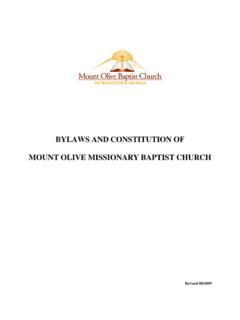Transcription of GERMAN BAPTIST SETTLEMENTS IN WESTERN CANADA
1 VOLHYNIAN BAPTIST SETTLEMENTS . IN WESTERN CANADA . by Donald N. Miller There were three major movements of GERMAN Baptists from Volhynia who settled in WESTERN CANADA . The first took place in the early 1890s until shortly after the turn of the century. The second occurred from 1926-1928. And the third covered the period from 1947 to 1972. Of course, there were some GERMAN Baptists from Volhynia who immigrated to CANADA prior to that time and subsequent to it, but the major SETTLEMENTS took place in these three phases. The First Wave, 1892-ca 1903. The first wave began with the organization of the first GERMAN BAPTIST church in WESTERN CANADA in 1886. It was located at Edenwald, near Regina, Saskatchewan. Although it was comprised primarily of people from Romania, it sensitized the leaders of the General Missionary Society of the GERMAN BAPTIST Churches of North America to the growing opportunity of ministry among Baptists from Eastern Europe.
2 That same year the Rev. F. A. Petereit , a young theological graduate from the GERMAN Department of the Rochester BAPTIST Seminary, came to Winnipeg, Manitoba to work with some 20 GERMAN -speaking Baptists, who had gathered together in a GERMAN Bible class in an English- speaking church . Some of them had come from Volhynia, Russia. Three years later, on December 31, 1899, the GERMAN BAPTIST church in Winnipeg was officially organized as a congregation. It soon became the mother church of many daughter churches in the West, as most GERMAN Russian immigrants, after making a brief stopover in Winnipeg, moved on to the West where homesteads were still available. Upon arrival, they soon gathered for worship and in time established new churches. In September 1892, during one of his missionary adventures to the North West, together with several GERMAN BAPTIST delegates from Manitoba and Saskatewan, Petereit formally recognized the first GERMAN BAPTIST church in Alberta.
3 It was located in Rabbit Hill, just south of Edmonton and called the Heimthal GERMAN BAPTIST church . Among the 17 charter members were a number of GERMAN BAPTIST families from Volhynia. Later, they called Rev. F. A. Mueller from Texas to become their first full-time pastor. Mueller had been pastor of a large GERMAN BAPTIST congregation in Lucinow, Volhynia, when he was forced out of the country for baptizing several Russians, which was strictly forbidden by the law. Mueller moved to Rabbit Hill in 1893 and took up the work. His coming opened the floodgates for many GERMAN Russian immigrants to come to America. According to David T. Priestley, former professor of Historical Theology at the Edmonton BAPTIST Seminary, After coming to Rabbit Hill, Mueller arranged for nearly 50 families to come from Volhynia to CANADA . First, they joined the Rabbit Hill BAPTIST church ; then, because the majority were homesteading inconveniently far to the southeast, they organized a new congregation near Leduc.
4 Soon after, Mueller resigned as pastor at Rabbit Hill to give more time to the larger church at Fredericksheim and the various stations it had begun near Wetaskawin and Millet. (Planting Churches in Alberta: 1890 to 1920, by David T. Priestley in the BAPTIST Herald). Mueller was a tireless pioneer missionary worker and evangelist. He not only recruited many GERMAN Baptists from Volhynia, but founded many new GERMAN BAPTIST congregations, largely within a 200-mile triangle in Central Alberta. Together with GERMAN BAPTIST immigrants, he was instrumental in organizing 10. churches in WESTERN CANADA , including the East Bittern Lake BAPTIST church , founded in 1901, which I attended as a boy. Among the charter members was the large well-known August Link family from Rogowka, Volhynia, who had filed for a homestead in the area in 1900. It has been suggested that Central Alberta has the largest concentration of Germans from Volhynia (and Poland) that can be found anywhere in the world today, and that one million Canadians claim whole or partial Ukrainian ancestry.
5 Many of the Germans from Volhynia in this first wave of immigration to CANADA came in search of a better way of life and in order to escape the Russian draft. The Second Wave, 1926-1928. In the second wave, the reasons for leaving Russia were more complicated and critical. With the Bolshevik take over in Russia, religious oppression, collectivization, and nationalization of land, many Germans reasoned that the time to leave had come. As early as 1922, reports and stories of hardship and suffering of the Volksdeutsche had come to the attention of Dr. Wilhelm Kuhn, General Secretary of the GERMAN BAPTIST Missionary Society. In 1926, Kuhn, together with E. P. Wahl, Hermann Streuber and F. A. Bloedow, spiritual leaders among the GERMAN Baptists, determined to undertake a relief program whereby GERMAN Baptists from Russia would be brought to CANADA in cooperation with the two Canadian railroads, which were eager to settle people in WESTERN CANADA .
6 Since many Canadian farmers were looking for cheap farm labor and the railroads were eager to settle the farms, this proved beneficial for both. As it turned out, it was also beneficial to the GERMAN BAPTIST movement in WESTERN CANADA , as most of these people joined the BAPTIST church or organized new congregations. It was not until 1926, however, that the GERMAN BAPTIST Relief and Immigration program got under way. On June 1, 1926, Wilhelm Kuhn wrote, We are bringing about 500 people from Russia, principally from Wolhynia. It is quite remarkable that these people can pay all their own transportation In addition to these 500 people, we have thousands more in our files, who are anxiously pleading to be brought to CANADA . ( BAPTIST Herald, June 1, 1926, p. 11). By the end of the year the GERMAN Society had brought 270 people to WESTERN CANADA , though not all came from Volhynia. In 1928 approximately 170 persons from the GERMAN BAPTIST church in Rozyszcze alone immigrated to CANADA .
7 Most of them settled in the Minitonas/Swan River area, in northern Manitoba. Robert J. Jacksteit, the former pastor who then lived in Minitonas assisted in the resettlement process. The program came to an abrupt halt in the latter part of 1928, (though a few slipped through as late as the fall of 1929) when the Russian Government closed the borders and refused to process anymore applications for immigration. It is not known how many people eventually came to CANADA as a result of this program, but here is a list of some of them: Adolph and Pauline Bandzmer Herta, Eugen, Erna Arrived in Halifax, NS on October 18, 1928. Emil and Maria Bonikowski Erich, Oscar, Erwin, Alma, Helmut, Frieda, Arthur, Bill, Rubin, Harry, Alice- Lillian, Helen, Agnes Arrived in Quebec, ONT. on May 23, 1927. Albert and ____Bredin Arrived in Karl and Augusta Busch Herta, Reinhart Arrived in Quebec, ONT on May 23, 1927.
8 Albert and Julia Edel Berta, Albert, Arthur, Sarah, Emma, Richard Arrived in Halifax, NS in October __1926. Ludwig Edel Arrived in Richard Eggert Leonid Eggert Arrived in Halifax, NS on October 18, 1928. Emma Gieger Berta, Wanda Arrived in Rudolf and Emma Gust Lena, Manuel Arrived in-----on October 27, 1927. Herbert Ikkert Arrived in David and ____Ittermann Arrived in St. John, NB on January 4, 1927. Krueger Leander and Olga Kuhn Meta Arrived in Reinholt and Lydia Lamprecht Lydia, Lily, Alfonze Arrived in Halifax, NS, March 28, 1928. Edmund and Olga Lange Assaf, Agatha, Alitza Arrived in Quebec, ONT. On August 5, 1927. --------Lueck Hugo Arrived in on Richard and Marie Milke Harry Arrived in Halifax, NS on October 18, 1928. Samuel and Tusnelda Mueller Arrived in Saint John, NB on February 8, 1927. Otto and Herta Nashilewski Arrived in Halifax, NS on July 5, 1928. Alexander Richter Arrived in Halifax, ONT.
9 On December---,1926. Adolf and Angela Rentz Lydia, Reuben, Eugene, Waldie, Willie, Eric and Agnes. Arrived in Halifax, NS on Alexander Richter Arrived in Halifax, ONT on December__1926. Jonathan Richter Jonathan and Olga Schlender Nellie Arrived in Quebec, ONT. September 17, 1926. Adoph and Elsa Schultz Adina, Linda, Sarah, Assaph, Bernard, Jonathan Arrived in Halifax, NS on June 11, 1927. Johann and Berta Siss Albert, Adeline, Linda, Alica Arrived in Halifax, NS in July__1928. Emil and Olga Stober Gertrud, Ella, Frieda, Paul, Mary, Elsie, ??? Arrived in November 16, 1928. Albert and Tabea Tiede Leon, Egardt Arrived in Quebec, Quebec Edward and Matilda Wuerch Arthur, Alice, Wilhelm, Angelica Arrived in Halifax, NS on _____. The Third Wave, 1947-1972. The third wave of GERMAN BAPTIST settlers in WESTERN CANADA began when CANADA reopened its gates to GERMAN immigrants in 1947. In that year the North American BAPTIST Conference (formerly the General Missionary Society of the GERMAN BAPTIST Churches of North America) created an immigration and colonization society for the express purpose of bringing BAPTIST refugees from Germany to CANADA .
10 Initially only those classified as Volksdeutsch were admitted. GERMAN nationals remained prohibited enemy aliens until September 1950. The mass migration to CANADA following World War II resulted from a powerful push and pull factor. Pressure to emigrate came from the unsettled conditions of those uprooted by the war and the search for a better life in the new world. William Sturhann, a GERMAN BAPTIST pastor from Morris, Manitoba, who played an important role in the immigration process, gave an additional reason for his denomination's involvement in the resettlement program. He said, Since we in CANADA desperately needed to add to our church membership, we looked at immigration not only as a matter of relief for the refugees, but also as a matter of economic necessity and self-help. (They Came From the East and West, p. 12). Most of the Germans were resettled in the early 1950s, though the resettlement of refugees continued for a number of years thereafter.





